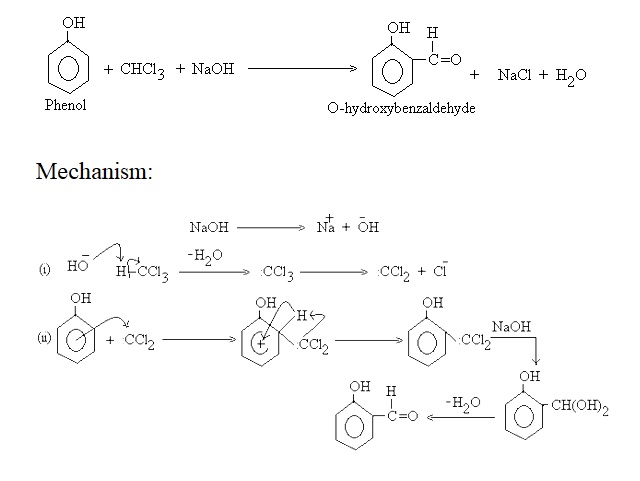Questions:
1) Peptide linkage is present in (Carbohydrates, Natural rubber, Proteins, Lipids).
Ans: Proteins
2) α- D (+) Glucose and β- D (+) Glucose are (Enantiomers, Geometrical Isomers, Epimers, Anomers).
Ans: Anomers
3) Write the IUPAC Name of C6H5 — CH = C (CH2CH3)CH2CH2OH
Ans: 3-ethyl-4-phenyl-3-buten-1-ol.
4) How can you find out whether a given amine is a primary amine?
Ans: By carbylamine reaction.
5) Why cannot cellulose be used as a food for human being?
Ans: Human being cannot use cellulose as a food due to lack of enzyme responsible for digestion of cellulose.
6) Write the mechanism of Reimer-Tiemann reaction.
Ans:
 7) What are homopolymers and copolymers?
7) What are homopolymers and copolymers?
Ans: Polymers prepared from only one kind of monomers, called homopolymers and polymers prepared from different kind of monomers, called co-polyners or mixed polymers.
8) Explain why aromatic amines are less basic than ammonia.
Ans: Aromatic amines are less basic than ammonia as aromatic amines can be stabilized by resonance.
9) What are essential amino acids?
Ans: Amino acids cannot be produced by human body are called essential amino acids. For examples, valine, leucine, isoleucine, phenylalanine, methionine, tryptophan, threonine, lysine, arginine and histidine.
10) What is mutarotation?
Ans: The two forms of α- and β-glucose exist in separate crystalline forms and have different m.p. and optical rotations. When either of these two forms are dissolved in water and allowed to stand, these get converted into the other form and an equilibrium mixture is formed with small amount of the open chain form:
![]()
The formation of an equilibrium mixture can be explained as the α-D-glucose has a specific rotation of +112° while β-D-glucose has a specific rotation of +19°. When α-form is dissolved in water, its specific rotation falls until a constant value of +52.7° is reached. On the other hand, when β-form is dissolved in water, its specific rotation increases and becomes constant at +52.7°. This change in optical rotation of a solution with time to an equilibrium value is called mutarotation.
11) Why α- helix structure of protein is named as 3.613 helix?
Ans: The α-helix structure is also known as 3.613 helix because each turn of the helix contains approximately 3.6 amino acids and a 13 member ring formed by hydrogen bonding. The helix is held in its shape primarily by hydrogen bonds between one amide group and carbonyl group which is 3.6 amino acids units away.
12) How would you prepare-
(i) 1-nitroprop-1-ene from acetaldehyde
(ii) Acetophenone from benzonitrile?
Ans: (i) When notromethane is treated with acetaldehyde give 1-nitroprop-1-ene.
CH3-NO2 + CH3-CHO —–> CH3-CH=CH-NO2 + H2O
(ii) When benzonitrile is treated with methyl magnesium bromide give an addition product which on acid hydrolysis gives acetophenone.

13) What are nucleotides?
Ans: When the phosphate group is attached to the nucleoside, the compound formed is called nucleotide. Thus a nucleotide contains a sugar unit linked to nitrogen base and phosphate group unit. Their structures are shown below.

14) What is a broad spectrum antibiotic?
Ans: Broad-spectrum antibiotics are medicines effective against a large number of harmful micro-organisms e.g. tetracycline, chloramphenicol, etc.
15) What type of dye is selected for nylon and silk yarns?
Ans: Direct dyes for examples martius yellow and Congo red.
16) Why aldehydes are more reactive than ketones towards nucleophilic addition reactions?
Ans: Aldehydes are more reactive than ketones towards nucleophilic addition reactions as ketones contain two alkyl group attached to carbonyl carbon.
17) What is Cannizzaro’s reaction?
Ans: Aldehydes lack of α-hydrogen atom undergoes Cannizzaro’s reaction with conc. NaOH solution to give methanol and sodium formate.
![]()
18) How can you distinguish acetophenone from benzophenone?
Ans: Acetophenone gives yellow precipitate with alkaline solution of iodine whereas benzophenone does not give this test.

19) How will you convert acetaldehyde into following molecules in not more than two steps?
(i) Butane-1, 3-dial
(ii) 3-oxobutanoic acid
Ans:
